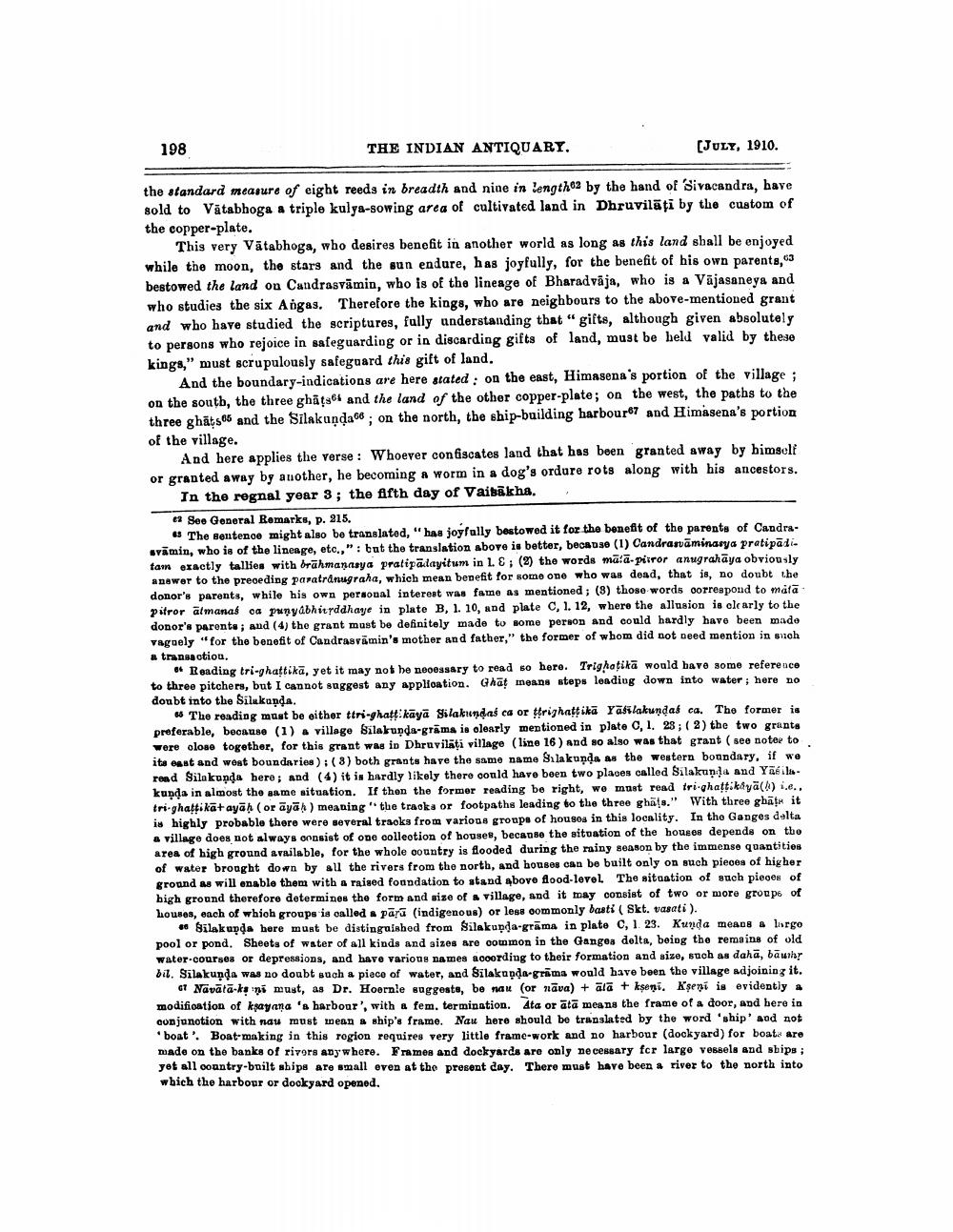________________
198
THE INDIAN ANTIQUARY.
[JULY, 1910.
the standard measure of eight reeds in breadth and nine in length02 by the hand of Sivacandra, have sold to Vătabhoga a triple kulya-sowing area of cultivated land in Dhruvilāți by the custom of the copper-plate.
This very Vätabhoga, who desires benefit in another world as long as this land shall be enjoyed while the moon, the stars and the sun endure, has joyfully, for the benefit of his own parents,43 bestowed the land on Candrasvāmin, who is of the lineage of Bharad vāja, who is a Vājasaneya and who studies the six Angas. Therefore the kings, who are neighbours to the above-mentioned grant and who have studied the scriptures, fully understanding that “gifts, although given absolutely to persons who rejoice in safeguarding or in discarding gifts of land, must be held valid by these kings," must scrupulously safeguard this gift of land.
And the boundary-indications are here stated : on the east, Himasena's portion of the village ; on the south, the three ghățget and the land of the other copper-plate; on the west, the paths to the three ghāts66 and the Silakundae ; on the north, the ship-building harbour67 and Himasena's portion of the village.
And here applies the verse : Whoever confiscates land that has been granted away by himselt or granted away by another, he becoming a worm in a dog's ordure rots along with his ancestors.
In the regnal year 3; the fifth day of Vaibākha. + See General Remarks, p. 215.
• The sentence might also be translated," has joyfully bestowed it for the benefit of the parents of Candra. svamin, who is of the lineage, etc.," : but the translation above is better, becausO (1) Candranāminarya pratipādi. tam exactly tallies with brāhmaṇasya pratipälayitum in L. ; (2) the words māla piror anugrahāya obviously anawer to the preceding paratranugraha, which mean benefit for some one who was dead, that is, no doubt the donor's parents, while his own personal interest was fame as mentioned; (3) those words correspond to måtā pitror almanas oa punyabhirddhaye in plato B, 1. 10, and plate C, 1. 12, where the allusion is clearly to the donor's parente; and (4) the grant must be definitely made to some person and could hardly have been mado vaguely "for the benefit of Candrasvämin's mother and father," the former of whom did not need mention in such a transaction.
" Reading tri-ghattikā, yet it may not be necessary to read so here. Trigotikā would have some reference to three pitchers, but I cannot suggest any application. Ghat means steps leading down into water; here no doubt into the Silukanda.
* The reading must be either tri-ghat: kaya Silakundasca or righatika Yaklakundas ca. The former is preferable, because (1) a village Bilakunda-grāms is olearly mentioned in plate C, 1. 28; (2) the two grants were close together, for this grant was ip Dhruvilāti village (line 16 ) and so also was that grant (see note to ita agat and west boundaries): (3) both grants have the same name Slakonda as the western boundary, if we read Silakunda here; and (4) it is hardly likely there could have been two places called Silakana and Yabila kunda in almost the same situation. If then the former reading be right, we must read tri ghattokyä(h) i.e.. tri ghaffikātayām (or āyā) ) meaning the tracks or footpathe leading to the three ghão." With three ghat it is highly probable there were several tracks from various groups of houses in this locality. In the Ganges delta
village does not always onnsist of one collection of houses, because the situation of the houses depends on the area of high ground available, for the whole country is flooded during the rainy season by the immense quantities of water brought down by all the rivers from the north, and houses can be built only on such pieces of higher ground as will enable them with a raised foundation to stand above food-level. The situation of such pieces of high ground therefore determines the form and size of a village, and it may consist of two or more group of houses, each of which groups is called s pará (indigenous) or less commonly basti (Skt. vasati).
* Silakunda here must be distinguished from Bilakupda-grāma in plato c, 1 23. Kunda means a largo pool or pond. Sheets of water of all kinds and sizes are common in the Ganges delta, being the remains of old water.courses or depressions, and havo various names according to their formation and size, such as dahā, bāuilar bil. Silakunda was no doubt such a piece of water, and Bilakuoda-grims would have been the village adjoining it.
of Navātā-ko ini must, as Dr. Hoornle suggests, be nau (or nāva) + alā + kseni. Kseni is evidently a modification of kayana 's harbour', with a fem. termination. Ata or ātā means the frame of a door, and bere in conjunotion with nau must means ship's frame. Nau here should be translated by the word 'ship' aod not 'boat'. Boat-making in this rogion requires very little frame-work and no harbour (dockyard) for boats are made on the banks of rivers anywhere. Frames and dockyards are only necessary for large vessels and abips; yot all country-built ships are small oven at the present day. There must have been a river to the north into which the harbour or dockyard opened.




